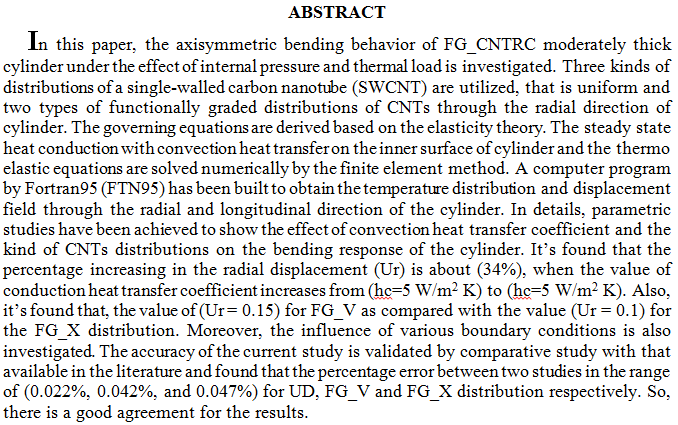
Coupling reaction of 2-amino benzoic acid with the 8-hydroxy quinoline gave the azo ligand (H2L): 5-(2-benzoic acid azo )-8-hydroxy quinoline.Treatment of this ligand with some metal ions (CoII, NiII and CuII ) in ethanolic medium with a (1:2) (M:L) ratio yielded a series of neutral complexes with general Formula[M(HL)2],where: M=Co(II), Ni(II) and Cu(II), HL=anion azo ligand (-1).The prepared complexes were characterized using flame atomic absorption,FT-IR and UV-Vis spectroscopic methods as well as magnetic susceptibility and conductivity measurements.
 (14)
(14)
 (7)
(7)
 (2)
(2)
 (2)
(2)
A numerical investigation has been performed to study the effect of eccentricity on unsteady state, laminar aiding mixed convection in a horizontal concentric and eccentric cylindrical annulus. The outer cylinder was kept at a constant temperature
while the inner cylinder was heated with constant heat flux. The study involved numerical solution of transient momentum (Navier-Stokes) and energy equation using finite difference method (FDM), where the body fitted coordinate system (BFC) was
used to generate the grid mesh for computational plane. The governing equations were transformed to the vorticity-stream function formula as for momentum equations and to the temperature and stream function for energy equation.
A computer progra
The Co (II), Ni (II) ,Cu(II), Zn(II) ,Cd(II) and Hg(II) complexes of mixed of amino acid (L-Alanine ) and Trimethoprim antibiotic were synthesized. The complexes were characterized using melting point, conductivity measurement and determination the percentage of the metal in the complexes by flame (AAS). Magnetic susceptibility, Spectroscopic Method [FTIR and UV-Vis]. The general formula have been given for the prepared mixed ligand complexes [M(Ala)2(TMP)(H2O)] where L- alanine (abbreviated as (Ala ) = (C5H9NO2) deprotonated primary ligand, L- Alanine ion .= (C5H8NO2 -) Trimethoprim (abbreviated as (TMP ) = C10H11N3O3S M(II) = Co (II),Ni(II) ,Cu(II), Zn(II) ,Cd(II) and Hg(II). The results showed that the deprotonated L- Alanine by KOH (Ala
... Show More (2)
(2)
 (3)
(3)
New mixed ligand complexes of New Schiff base 4,4'- ((naphthalen-1-ylimino) methylene) dibenzene-1,3-diol and 8-hydroxy quinoline: Synthesis, Spectral Characterization, Thermal studies and Biological Activities
The research aims mainly to the role of the statement style costs on the basis of activity based on performance (PFABC) to reduce production cost and improve the competitive advantage of economic units and industrial under the modern business environment dominated by a lot of developments and changes rapidly, which necessitates taking them and criticize them to ensure survival and continuity. The research problem is the inability of traditional cost methods of providing useful information to the departments of units to take many administrative decisions, particularly decisions related to the product and calculating the costs of the quality of the sound and the availability of the need and the ability to replace methods capa
... Show More (8)
(8)
 (7)
(7)
The reaction of 1,5-dimethyl-2-phenyl-1H-pyrazol-3(2H)-one with one equivalent of 4-chlorophenol by coupling reaction afforded (E)-4-((5-chloro-2- hydroxyphenyl)diazenyl)-1,5-dimethyl-2-phenyl-1H-pyrazol-3(2H)-one. Then azo ligand was characterize using spectroscopic studies ( FTIR,UV-Vis, 1H and 13CNMR, Mass) also micro-elemental analysiz (C.H.N.O). Transition metal chelation with Co(II), Ni(II), Cu(II), and Zn(II) was investigated, revealing 1:2 metal-to-ligand stoichiometry with octahedral geometry. The biological, and industrial application for the azo ligand and it is complexes were evaluated, demonstrating antimicrobial activity against bacterial and fungal strains, with the Zn(II) complex exhibiting superior inhibition. Additionally,
... Show More